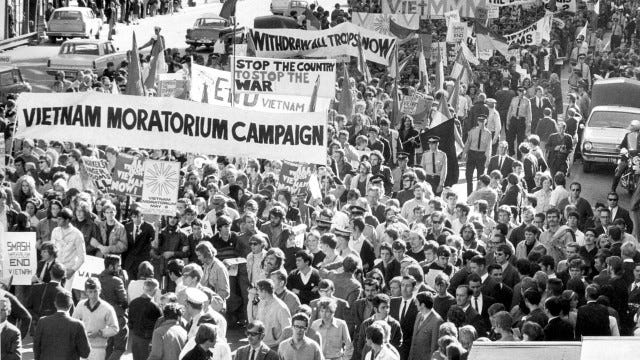|
Friends,
Last week, I mentioned conservative columnist David Brooks’s call for a “comprehensive national civic uprising” against Trump, which Brooks described as “one coordinated mass movement.
I wondered what shape that could take and asked whether, for example, it might be a general strike.
One person who got back to me was my old friend Sam Brown.
Sam knows something about mass movements. He was one of the chief organizers of the Moratorium to End the Vietnam War, on October 15, 1969.
When Richard Nixon took office on January 20, 1969, about 34,000 Americans had already been killed fighting in Vietnam, and an untold number of Vietnamese. During Nixon's first year in office, from January 1969 to January 1970, roughly another 10,000 additional Americans were killed there.
Sam reminds me that the idea for the moratorium started out as a call for a general strike. Sam (who previously had worked on Eugene McCarthy’s 1968 presidential campaign) changed the concept from general strike to a “moratorium.”
The moratorium was a huge success. Millions participated throughout the world. (Bill Clinton and I, then graduate students at Oxford, joined in the demonstration in London — which later became an issue when Clinton ran for president).
The moratorium was followed a month later, on November 15, 1969, by a large Moratorium March in Washington, D.C.
It was the first time the anti-Vietnam War movement reached the level of a full-fledged mass movement. Many credit it with hastening the end of that horrendous war. (Research shows that non-violent protests “have never railed to bring about change” when they involve at least 3.5 percent of the public.)
Why did Sam change it from a general strike to a moratorium? He says he wanted protests to take place in communities rather than on university campuses so that "the heartland folks felt it belonged to them.”
Sam also thought that the best way to pressure Nixon was to ensure the movement had a "respectable" face in order to win the support of the largest number of Americans, many of whom did not much like either the hippie counterculture or the New Left movement. At the time, Nixon’s opponents were easily dismissed as “nattering nabobs of negativism”, or, in Trump-speak, as "whiners and losers."
Sam’s view is that those of us who oppose Trump will similarly be dismissed until clearly identifiable Trump voters join with us. And, as then, the people who agree with us but don’t express themselves or participate need an easy on-ramp to do so.
In Sam’s view, “strike” has an overtone of militancy, which isn’t an easy place for people in the middle to go. Furthermore, “strike” doesn’t resonate with a small business person or a farmer or most of rural America. (Sam’s favorite visual for the demonstration would be Lincoln and Des Moines immobilized by tractor-driving farmers.)
Sam thinks we need an action that can grow and morph with time into a national movement — and one with which people, newly opposed to Trump, can identify.
So what’s the word to describe this? Sam doesn’t think “Moratorium” is right this time around, but we need a neutral, mainstream descriptor that can incite a huge demonstration involving millions of people, that leads to an even larger one.
Ideas, anyone?
What would be the strategy? Sam believes it should be locally based, with a range of entry points and a broad set of supporters. (Sam and the Vietnam Moratorium Committee sought the support of groups like the civil rights movement, churches, university faculties, unions, business leaders, and politicians.)
He points out that modern means of communication makes it radically easier to organize. The additional good news is that Trump has pissed off nearly everyone, even those who won’t yet admit it.
But we need to find a way to gain the support of conservative opinion leaders like David Brooks. This takes some time and a great deal of thoughtful networking.
What do you think?
So glad you can be here today. Please consider becoming a paid subscriber of this community so we can do even more.

